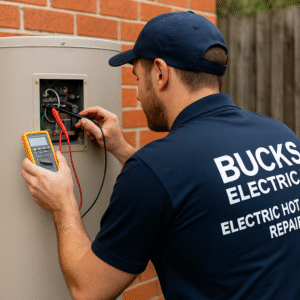Upgrading your home’s electrical panel is a crucial step in ensuring safety, efficiency, and the ability to handle modern power demands. An electric panel upgrade increases capacity, prevents circuit overloads, and allows your home to support high-powered appliances and smart home technology. However, the process must be handled carefully, as mistakes can lead to costly repairs, safety hazards, and non-compliance with local codes.
In this article, we’ll explore the most common mistakes homeowners and contractors make during an electric panel upgrade, and provide guidance on how to avoid them to ensure a safe and effective electrical system.
Why an Electric Panel Upgrade Matters
Before diving into common mistakes, it’s important to understand why an electric panel upgrade is essential:
-
Increased Power Capacity: Older panels may not handle today’s high-demand devices, leading to tripping breakers or dimming lights.
-
Enhanced Safety: Modern panels include circuit breakers, surge protection, and grounding features to prevent electrical hazards.
-
Support for Smart Homes: Smart devices, EV chargers, and energy-efficient systems require a stable and reliable electrical panel.
-
Home Value: Upgraded electrical panels increase property value and attract buyers who want a modern, safe electrical system.
Mistake 1: Skipping a Professional Assessment
One of the biggest mistakes homeowners make is attempting to upgrade without a proper assessment. Assessing your home’s current electrical system is critical to determine:
-
Existing load and capacity
-
Number of circuits needed
-
Compatibility with modern devices
-
Potential upgrades to wiring or grounding
Without a professional assessment, you may end up with an underpowered panel, inadequate circuit distribution, or unsafe connections. Always involve a licensed electrician when planning an electric panel upgrade.
Mistake 2: Choosing the Wrong Panel Size
Selecting an electric panel that is too small or too large can cause problems:
-
Undersized Panels: May not accommodate future devices, leading to frequent trips or overloads.
-
Oversized Panels: Can be unnecessarily expensive and may require unnecessary wiring modifications.
A proper electric panel upgrade requires choosing a panel that matches your current and anticipated electrical needs. A professional can calculate your home’s load requirements to determine the correct panel size.
Mistake 3: Ignoring Code Compliance
Electrical codes are designed to ensure safety and prevent hazards. Some homeowners or unlicensed contractors may skip obtaining permits or following code requirements. Common violations include:
-
Improper grounding
-
Incorrect breaker installation
-
Overcrowding circuits in the panel
-
Using outdated or substandard materials
Ignoring codes during an electric panel upgrade can result in fines, failed inspections, or safety risks. Always work with licensed professionals who are familiar with local building codes.
Mistake 4: Overloading the Panel
An electric panel upgrade is meant to increase capacity, but some homeowners mistakenly try to add too many high-powered appliances to a single panel. Overloading can cause:
-
Frequent breaker trips
-
Voltage fluctuations
-
Overheating and fire hazards
Ensure that circuits are properly distributed and consider adding dedicated circuits for high-demand devices like EV chargers, smart appliances, or home offices.
Mistake 5: Neglecting Grounding and Surge Protection
Grounding and surge protection are often overlooked but are essential for safety:
-
Grounding: Provides a safe path for electricity in case of faults or short circuits.
-
Surge Protection: Protects appliances and electronics from voltage spikes.
Skipping these during an electric panel upgrade can leave your home vulnerable to electrical fires, equipment damage, and unsafe conditions. Modern panels often include built-in surge protection and grounding options that should never be ignored.
Mistake 6: DIY Installation
While some homeowners may attempt a DIY electric panel upgrade to save money, this is extremely dangerous. Mistakes in wiring, breaker installation, or grounding can result in:
-
Electrical shocks
-
Fire hazards
-
Damaged appliances
-
Non-compliance with codes
Always hire a licensed electrician with experience in panel upgrades to ensure the work is safe and code-compliant.
Mistake 7: Failing to Plan for Future Needs
Many homeowners only upgrade their panel to address immediate issues and neglect future electrical demands. This can lead to:
-
Insufficient capacity for smart home technology
-
Difficulty adding EV chargers, additional circuits, or high-powered appliances
-
Frequent need for another upgrade in a few years
A successful electric panel upgrade should account for both current and future electrical needs, providing flexibility and avoiding repeated upgrades.
Mistake 8: Ignoring Old or Damaged Wiring
An upgraded panel cannot function efficiently if the existing wiring is old or damaged. Common issues include:
-
Frayed or corroded wires
-
Outdated aluminum wiring
-
Insufficient wire gauge for new circuits
During an electric panel upgrade, inspect the home’s wiring and replace or upgrade it as needed to ensure safety and reliable operation of the electrical system.
Mistake 9: Skipping Testing and Inspection
After an electric panel upgrade, testing and inspection are critical to ensure proper function. Neglecting this step can result in:
-
Undetected loose connections
-
Circuit imbalances
-
Inaccurate breaker functionality
-
Hidden fire hazards
Professional electricians perform thorough testing and inspections, including voltage checks, load testing, and code compliance verification, to ensure the upgrade is safe and effective.
Mistake 10: Overlooking Labeling and Organization
A well-organized and labeled panel is essential for safety and maintenance. Common errors include:
-
Missing or unclear circuit labels
-
Poor wire management
-
Unclear identification of high-demand or dedicated circuits
Proper labeling during an electric panel upgrade helps homeowners and electricians quickly identify circuits, troubleshoot issues, and maintain the system safely.
Tips for a Successful Electric Panel Upgrade
-
Hire Licensed Professionals: Ensure the job is done safely and in compliance with local codes.
-
Plan for Future Needs: Include additional capacity for new devices, appliances, or smart home technology.
-
Inspect Wiring: Upgrade old, damaged, or insufficient wiring for reliable performance.
-
Include Safety Features: Install surge protection, proper grounding, and modern breakers.
-
Test and Inspect: Verify that all circuits function correctly and meet code requirements.
-
Label Circuits Clearly: Maintain a well-organized panel for safety and easy maintenance.
-
Budget Properly: Account for labor, materials, and potential wiring upgrades in addition to the panel cost.
Conclusion
An electric panel upgrade is an important investment in your home’s safety, efficiency, and ability to support modern electrical demands. However, mistakes during the upgrade can lead to serious hazards, costly repairs, and non-compliance with local codes.
By avoiding common errors—such as DIY installation, ignoring code compliance, overloading circuits, neglecting wiring and safety features, and failing to plan for future needs—you can ensure a safe, reliable, and efficient electrical system.
For professional installation, expert guidance, and safe electrical upgrades, partnering with Madison Electric Company guarantees that your electric panel upgrade is performed safely, efficiently, and in compliance with all local codes, providing peace of mind and reliable power for years to come.

